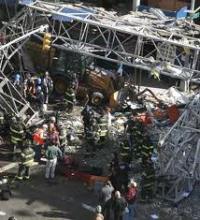Trial Begins for Operator Involved in Fatal Upper East Side Crane Collapse
By Daniel Edward Rosen February 22, 2012 9:00 am
reprintsThe Manhattan District Attorney’s office yesterday opened up its manslaughter trial against the owner of a construction crane involved in a 2008 accident that killed two workers, and prosecutors said it was that man’s greed that lead to the fatal crane collapse, according to the Associated Press.
Prosecutors painted James Lomma, the head of New York Crane & Equipment Corp., as a man who passed on a crucial repair job on the faulty crane in favor of the bottom line.

“They were killed because of one man’s greed,” said Manhattan District Attorney Eli Cherkasky in his opening statements inside a packed Manhattan Supreme Courtroom Tuesday, according to an Associated Press report.
Mr. Lomma is currently standing criminal trial for the 2008 crane collapse that took place on East 91st Street. The 200-foot crane was working on the 14th floor of a high rise residential development when the top part of the crane broke off. The debris then fell into the building and down below, crushing a sewer company worker, Ramadan Kurtaj, 27. The collapse also nearly beheaded Donald Leo, 30, who was in the crane’s cab during the time of the accident. Both men died. A third construction worker, Simeon Alexis, was seriously injured.
In its 2010 indictment, prosecutors said Mr. Lomma, 66, and mechanic Tibor Varganyl used Chinese firm RTR Bearing to replace a cracked turntable on the crane, which allows the upper parts of the rig to swivel.
Mssrs. Lomma and Varganyl were told by two other companies that work on replacing the turntable would take at least seven months and $34,000. RTR Bearing pledged to come up with the part for nearly $20,000 in three months, prosecutors said at the time.
But even RTR Bearing had its doubts about the repair, sending an email that warned “we don’t have confidence on this welding,” prosecutors said.
Manhattan District Attorney Cy Vance, Jr. accused Lomma of wanting to speed up repairs to the 25-year-old crane to prevent losing roughly $50,000 in rental fees for leasing out the rig to other companies.
Mr. Varganyi, 65, plead guilty to criminally negligent homicide and is expected to be sentenced in April. He could possibly avoid jail time if he testifies against Mr. Lomma, The Associated Press reported.
“This five week trial will show that James Lomma had acted entirely responsibly, and the prosecution’s opening statement was more fiction than fact,” Paul Schechtman, one of Mr. Lomma’s defense attorneys, told The Commercial Observer yesterday.
This crane accident happened two months after a separate crane collapse in Manhattan killed seven people.
Since 2008, the city Department of Buildings has implemented more than 25 new construction safety laws, created new inspectorial units, and increased training of its employees, said Tony Sclafani, a spokesman for the city agency.
“The Building Department has really clamped down on who is operating, who is responsible, who’s got licenses, whether they’re trained, I think there has been a vast tightening of the protocols for insuring greater compliance and the penalties for non-compliance, if there are any future incidences,” said Barry LePatner, an authority on construction and founder of law firm LePatner & Associates who authored the books “Broken Buildings, Busted Budgets” and “Too Big to Fall.”
The new mandates pushed forth by the Department of Buildings, which includes increasing the number of crane parts privy to inspection from 35 to 200, has lead to a 18 percent drop in construction accidents in 2011, added Mr. Sclafani.
“Stricter enforcement and increased industry outreach has created a greater result of safety throughout the industry,” said Mr. Sclafani.
That’s not to say crane accidents no longer occur in New York City.
Last week, a crane situated atop the 4 World Trade Center development was lifting a load of steel beams when its crane cable popped, sending the steel to fall 40 stories below and on top of a flatbed truck. A construction worker was slightly injured on the scene.
That accident is still under investigation, said Mr. Sclafani.
Drosen@observer.com


